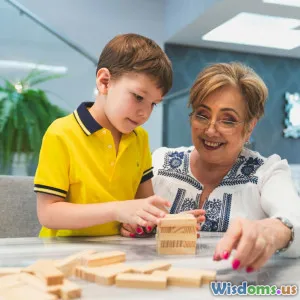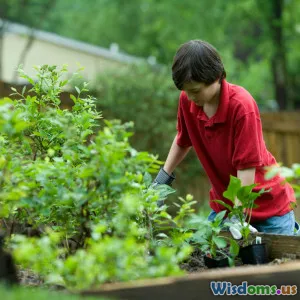
The Rise of Multigenerational Living Pros and Cons
9 min read Explore the surge in multigenerational living, its advantages, challenges, and its impact on modern households worldwide. (0 Reviews)
The Rise of Multigenerational Living: Pros and Cons
Introduction
Imagine a household where your grandparents, parents, children, and even great-grandchildren live under the same roof, sharing meals, laughter, and responsibilities. This isn’t an ancient relic of past cultures but a burgeoning trend capturing modern family life across the world. Multigenerational living, the practice of more than two generations cohabiting, has seen a significant rise in popularity over recent years. Whether driven by financial necessity, cultural values, or the desire for stronger familial ties, it's reshaping the landscape of domestic life.
According to the Pew Research Center, in the United States, the share of Americans living in multigenerational households rose from 12% in 1980 to nearly 20% by 2021, revealing a growing preference or necessity for these arrangements. But what fuels this upswing? And, crucially, what are the benefits and drawbacks of bringing together generations with vastly different life experiences, habits, and expectations?
This article dives into the multifaceted world of multigenerational living, offering a balanced look at why families choose this path and what families stand to gain or potentially lose.
Understanding Multigenerational Living
Multigenerational households typically include grandparents, their adult children, and grandchildren, sometimes extending to even older ancestors or younger generations beyond a nuclear family. The arrangement varies across cultures but often entails shared responsibilities, communal decision-making, and intertwined daily routines.
This living pattern is not new globally—many Asian, Latino, and African cultures have historically embraced such family models. Economic challenges and evolving social dynamics have reintroduced this way of living in Western societies as well.
The Drivers Behind the Rise
Several factors contribute to multigenerational living’s surge:
- Economic Pressures: Rising housing costs, student debt, and economic uncertainty often make single-household living unaffordable. For example, post-recession economic data reveal that adult children moving back home often cite job instability as a primary reason.
- Aging Population: With medical advancements, people live longer, healthier lives, often requiring family care.
- Cultural Continuity: Cultural traditions promote closeness with extended family, providing emotional and social support.
- Childcare Needs: Families with young children may benefit from grandparents’ involvement for childcare.
Pros of Multigenerational Living
1. Financial Advantages
Pooling resources can significantly ease economic burdens. Shared household expenses, from utilities to property taxes, help families save money.
A 2018 Harvard Joint Center for Housing Studies report noted that multigenerational households spend up to 60% less per person on housing than separate households. By sharing space, families can live in safer neighborhoods or larger homes at a fraction of the cost.
2. Enhanced Family Bonding and Emotional Support
Living together often strengthens family ties. Grandparents can build closer relationships with grandchildren fostering emotional resilience.
Moreover, older adults benefit from regular interaction, reducing risks of isolation and depression. For children, growing up around multiple generations imparts diverse perspectives and values.
Dr. Laura Carstensen, Director of Stanford’s Center on Longevity, explains, “Intergenerational contact promotes empathy and support systems that act as a buffer against life stresses.”
3. Shared Caregiving Responsibilities
Multigenerational homes can facilitate caregiving for aging relatives or help parents manage childcare, creating natural support ecosystems.
In many households, older family members assist with cooking, babysitting, or transportation, freeing considerable time and resources for working adults.
4. Cultural Preservation
For immigrant families and ethnic minorities, multigenerational living aids in preserving language, customs, and traditions, offering the younger generations a robust sense of identity.
Cons of Multigenerational Living
1. Privacy and Personal Space Challenges
A shared home can strain privacy. Conflicting routines or preferences — such as sleeping habits, noise levels, or visitors — may breed frustration.
Especially in smaller houses or apartments, limited personal space can cause tension or feelings of being constantly monitored.
2. Generational Differences and Conflict
Different values and expectations across generations can create misunderstandings, power struggles, or disciplinary conflicts.
For example, older adults might have traditional views clashing with younger generations' ideologies, influencing child-rearing or household management decisions.
Such conflicts, if unresolved, can fester, impacting mental health and family harmony.
3. Financial Strains and Inequality
While sharing expenses can ease costs, differences in financial contribution may create disputes or dependency concerns.
Families must negotiate fairly how bills, chores, and responsibilities are divided to avoid resentment.
According to surveys, perceived imbalance in contribution—whether monetary or labor—remains a common pitfall.
4. Impact on Autonomy
Younger adults may feel constrained by family dynamics, limiting their independence or freedom, especially regarding social life and lifestyle choices.
Similarly, elderly members might resist adapting to new ways, limiting inter-family flexibility.
Real-World Examples
-
Japan’s Increasing Multigenerational Homes: With one of the world’s fastest-aging populations and rising elder care costs, Japanese families increasingly opt for multigenerational living, supported by government programs. This approach practically shares caregiving and harnesses cultural reverence for elders.
-
U.S. Millennials Returning Home: Post-Great Recession decades showed millennials moving back home in record numbers—primarily due to unemployment, student debts, and rising housing prices. Though sometimes seen as a setback, families often developed resilience and stronger bonds.
-
Latino Households in the U.S.: Studies reveal that Latino families are nearly twice as likely to live in multigenerational homes compared to the national average, blending economic need and cultural tradition.
Tips for Successful Multigenerational Living
To maximize benefits and minimize conflict, families might:
- Establish Clear Boundaries: Define private spaces and times for personal activities.
- Communicate Openly: Regular family meetings to discuss concerns and responsibilities.
- Schedule Alone Time: Encourage each person’s independence and hobbies outside the home.
- Set Financial Agreements: Clarify household expenses and contributions transparently.
- Respect Differences: Foster empathy across generational perspectives.
Conclusion
The rise of multigenerational living reflects a shift in how families contend with economic realities, aging populations, and cultural aspirations. While the model offers profound benefits, such as financial relief, emotional support, and cultural continuity, it also demands navigation of interpersonal challenges, privacy concerns, and generational conflicts.
For many, the journey of blending several generations under one roof requires patience, understanding, and adaptability. Yet, the potential rewards—a deeply rooted sense of belonging, shared kindness, and collective resilience—can redefine the meaning of home and family.
As demographics and economies continue to evolve, multigenerational living may well become a pillar of modern society, offering lessons in cooperation and care that few other arrangements can match.
Whether you are contemplating this lifestyle or simply curious, understanding the nuanced pros and cons is essential. By taking informed steps, families can build households not just of shared space but shared strength.
Rate the Post
User Reviews
Popular Posts




















